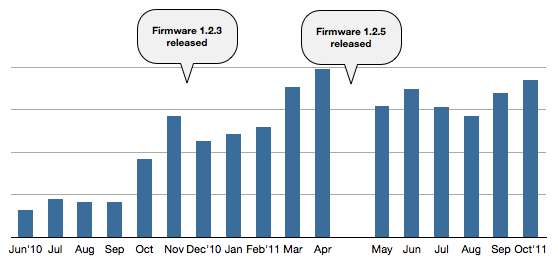Does FW1.2.5 Fix Canon 7D Reliability Problem?
Canon EOS cameras offer great things to videographers. But since video recording was added to 5D Mark II and then to 7D, there has also been a big number of reliability problems.
Canon EOS is “producing” an order of magnitude more repairs than other consumer cameras that outsell Canon 7D in the market.
Our job is to repair video files, so we are in a position to say something about it. Over the last two years, Canon EOS repairs have sky-rocketed, quickly becoming our main “product”. In most cases, a few clips shot during an event are corrupt, despite having recorded good clips before and after. The media data is present and is consistent (a condition to make the repair possible), but the movie index is missing.

It’s as if the camera had stopped working in the middle of the recording, or could not finish its job of adding the index just after recording ends. This smells like a firmware bug or system limitation. In any case, this is something that Canon can only hope to solve through a firmware upgrade — or — a new camera design.
(There are other failure modes found in Canon EOS cameras, like use of low performance CF cards, accidental deletion, battery issue … but those are the “usual suspects” that we find in all cameras. Here we focus on top Canon-specific failure mode: corrupt file due to firmware bug or system limitation).
FW1.2.5: Canon Acknowledges the Problem
In April 2011, Canon has released a new firmware, FW1.2.5, for Canon 7D.
According to Canon, Firmware 1.2.5 should eradicate corrupt movies:
“Fixed a rare phenomenon in which there were rare cases where movie files taken could not be opened when repeatedly shooting movies with specific CF cards.”
Strange wording. “Rare cases”, “specific CF cards”, look like words forced by PR or Marketing department, and in my opinion, try to masquerade the fact that Canon has only partially solved the problem (or the problems) and that you should not be surprised if failures keep occurring…
So I decided to dig into our repair history and figure out whether FW1.2.5 has changed anything over the last 6 months.
First, I notice that after FW1.2.5 release, our Canon repairs drop by 15%, then they start growing again, but at a slower pace than before.

How Firmware Roll-Overs Work
When a new firmware is released, all new cameras are manufactured with it. But it can take a few months until those cameras get into customers hands. If distribution and sales channel is slow, if inventory doesn’t receive the upgrade, the old firmware will continue growing in installed based for many months until new one first appears, then becomes significant.
Firmware upgrade is also possible on older cameras. But my guess is that only a small percentage of people is upgrading its camera firmware. One exception: if they are confronted to a problem, or receive advice to do so by Canon support, in a newsletter or in an Internet forum, they will upgrade.
FW1.2.3 Roll-Over as a Baseline
FW1.2.3 is transparent: It doesn’t claim to fix any failure mode causing corrupt clips.
That’s why it’s a good baseline to see how firmware roll-overs happen in Canon EOS world.
We look at the picture 6 months after the release to give it time to significantly affect the installed base through new sales and manual upgrades. The chart shows how repair cases are distributed by firmware versions:

- After 6 months, the latest firmware accounts for 18% of repairs.
- FW1.2.2, the last one, is now the most represented. This is due to inertia of installed based and sales channel.
Now with FW1.2.5, a Different Story
The big change with FW1.2.5 is that it claims to solve clip corruption issues. So all other things being equal, we will evaluate the efficiency of the firmware fix by comparing the occurrence of repair cases.
If FW1.2.5 were not fixing the bug, then 6 months after release, the distribution of repair cases by firmware releases would look exactly like the FW1.2.3 chart (see above).
It turns out that it’s NOT the same:

The significant differences and their possible explanation are:
- Volume of repairs decreases by 15% (as noted in first chart). Sounds like there is improvement!
- FW1.2.5 represents only 12% of total, which is significantly lower than 18% of FW1.2.3 six months earlier.
- Considering growth of installed base (with important FW1.2.3 inertia and FW1.2.5 in most recent sales), FW1.2.3 should be the most frequent version, but its volume is almost the same as six month earlier!
- We see an important and unexpecte decrease in FW1.2.2.
I can only understand those results by imagining that customers have upgraded en masse from FW1.2.2 and FW1.2.3 to new FW1.2.5. This is probably due to Canon pushing FW1.2.5 as a “problems killer”, and due to Canon users advocating for upgrading firmware in Internet discussions.
But then, FW1.2.5 should now the most frequent in the Repair Cases. And actually, it’s the less frequent one!
This can only be because FW1.2.5 is producing significantly less corrupt movies than the previous versions.
Conclusion
To all Canon 7D users: Please upgrade to FW 1.2.5 and do it fast or you will have to use our Movie Repair Service!

